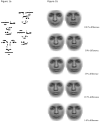Visual and cognitive processing of face information in schizophrenia: detection, discrimination and working memory
- PMID: 18947982
- PMCID: PMC2640943
- DOI: 10.1016/j.schres.2008.09.010
Visual and cognitive processing of face information in schizophrenia: detection, discrimination and working memory
Abstract
Face recognition involves several physiological and psychological processes, including those in visual, cognitive and affective domains. Studies have found that schizophrenia patients are deficient at recognizing facial emotions, yet visual and cognitive processing of facial information in this population has not been systematically examined. In this study, we examined visual detection, perceptual discrimination and working memory of faces as well as non-face visual objects in patients. Visual detection was measured by accuracy when detecting the presence of a briefly displayed face, image which contained only the basic configural information of a face. Perceptual discrimination was measured by discriminability scores for individual facial identity images, in which the degree of similarity between images was systematically varied via morphing. Working memory was measured by the discriminability scores when two comparison face images were separated by 3 or 10 s. All measurements were acquired using a psychophysical method (two-alternative forced choice). Relative to controls, patients showed significantly reduced accuracy in visual detection of faces (p=0.003), moderately degraded performance in perceptual discrimination of faces (p=0.065), and significantly impaired performance in working memory of faces (p<0.001 for both 3 and 10 sec conditions). Patients' performance on non-face versions of these tasks, while degraded, was not correlated with performance on face recognition. This pattern of results indicates that greater signal strength is required for visual and cognitive processing of facial information in schizophrenia.
Conflict of interest statement
Conflict of Interest: All authors declare that they have no conflicts of interest.
Figures




Similar articles
-
Association of impaired facial affect recognition with basic facial and visual processing deficits in schizophrenia.Biol Psychiatry. 2009 Jun 15;65(12):1094-8. doi: 10.1016/j.biopsych.2009.01.026. Epub 2009 Mar 6. Biol Psychiatry. 2009. PMID: 19268917
-
The other-race effect in face processing among African American and Caucasian individuals with schizophrenia.Am J Psychiatry. 2008 May;165(5):639-45. doi: 10.1176/appi.ajp.2007.07101604. Epub 2008 Mar 17. Am J Psychiatry. 2008. PMID: 18347000 Free PMC article.
-
Distinct facial processing in schizophrenia and schizoaffective disorders.Schizophr Res. 2012 Jan;134(1):95-100. doi: 10.1016/j.schres.2011.08.001. Epub 2011 Aug 24. Schizophr Res. 2012. PMID: 21868199 Free PMC article.
-
[Working memory in schizophrenia: a review].Encephale. 2008 Jun;34(3):289-98. doi: 10.1016/j.encep.2006.12.008. Epub 2007 Oct 24. Encephale. 2008. PMID: 18558152 Review. French.
-
Object-location memory in schizophrenia: interference of symbolic threatening content.Cogn Neuropsychiatry. 2006 May;11(3):272-84. doi: 10.1080/13546800500214041. Cogn Neuropsychiatry. 2006. PMID: 17354072 Review.
Cited by
-
Resting-state degree centrality and Granger causality analysis in relation to facial working memory in patients with first-episode schizophrenia.BMC Psychiatry. 2025 Feb 19;25(1):147. doi: 10.1186/s12888-025-06535-7. BMC Psychiatry. 2025. PMID: 39972263 Free PMC article.
-
Patients with schizophrenia show increased aversion to angry faces in an associative learning task.Psychol Med. 2011 Jul;41(7):1471-9. doi: 10.1017/S0033291710001960. Epub 2010 Oct 20. Psychol Med. 2011. PMID: 20961475 Free PMC article.
-
Are patients with schizophrenia impaired in processing non-emotional features of human faces?Front Psychol. 2013 Aug 20;4:529. doi: 10.3389/fpsyg.2013.00529. eCollection 2013. Front Psychol. 2013. PMID: 23970872 Free PMC article.
-
Face identity discrimination in schizophrenia: Impairments to faces with high exposure in society.Schizophr Res. 2016 Mar;171(1-3):237-8. doi: 10.1016/j.schres.2016.01.009. Epub 2016 Jan 15. Schizophr Res. 2016. PMID: 26781002 Free PMC article. No abstract available.
-
Facial emotion perception abilities are related to grey matter volume in the culmen of cerebellum anterior lobe in drug-naïve patients with first-episode schizophrenia.Brain Imaging Behav. 2022 Oct;16(5):2072-2085. doi: 10.1007/s11682-022-00677-y. Epub 2022 Jun 25. Brain Imaging Behav. 2022. PMID: 35751735
References
-
- Archer J, Hay DC, Young AW. Face processing in psychiatric conditions. Br J Clin Psychol. 1992;31(Pt 1):45–61. - PubMed
-
- Bokde AL, Dong W, Born C, et al. Task difficulty in a simultaneous face matching task modulates activity in face fusiform area. Brain Res Cogn Brain Res. 2005;25(3):701–10. - PubMed
-
- Bruce V, Young A. Understanding face recognition. Br J Psychol. 1986;77(Pt 3):305–27. - PubMed
-
- Calkins ME, Gur RC, Ragland JD, et al. Face recognition memory deficits and visual object memory performance in patients with schizophrenia and their relatives. Am J Psychiatry. 2005;162:1963–6. - PubMed
Publication types
MeSH terms
Grants and funding
LinkOut - more resources
Full Text Sources
Medical

